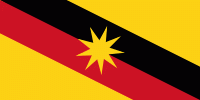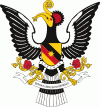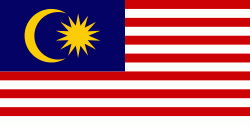Sarawak
 |
 |
The earliest known human settlement in Sarawak at the Niah Caves dates back 40,000 years. A series of Chinese ceramics dated from the 8th to 13th century AD was uncovered at the archaeological site of Santubong. The coastal regions of Sarawak came under the influence of the Bruneian Empire in the 16th century. In 1839, James Brooke, a British explorer, arrived in Sarawak. He, and his descendants, governed the state from 1841 to 1946. During World War II, it was occupied by the Japanese for three years. After the war, the last White Rajah, Charles Vyner Brooke, ceded Sarawak to Britain, and in 1946 it became a British Crown Colony. On 22 July 1963, Sarawak was granted self-government by the British and subsequently became one of the founding members of Malaysia, established on 16 September 1963. However, the federation was opposed by Indonesia, leading to a three-year confrontation. The creation of Malaysia also prompted a communist insurgency that lasted until 1990.
The head of state is the Governor, also known as the Yang di-Pertua Negeri, while the head of government is the Premier. Sarawak is divided into administrative divisions and districts, governed by a system that is closely modelled on the Westminster parliamentary system and was the earliest state legislature system in Malaysia. Under the Malaysian constitution, Sarawak has greater autonomy than the states of Peninsular Malaysia.
Because of its natural resources, Sarawak specialises in the export of oil and gas, timber and oil palms, but also possesses strong manufacturing, energy and tourism sectors. It is ethnically, culturally, and linguistically diverse; major ethnic groups including Iban, Malay, Chinese, Melanau, Bidayuh and Orang Ulu. English and Malay are the two official languages of the state; there is no official religion.
The generally-accepted explanation of the state's name is that it is derived from the Sarawak Malay word Serawak or Cerava by Portuguese chartographers in the 16th century, which means antimony. A popular alternative explanation is that it is a contraction of the four Malay words purportedly uttered by Pangeran Muda Hashim (uncle to the Sultan of Brunei), "Saya serah pada awak" (I surrender it to you), when he gave Sarawak to James Brooke, an English explorer in 1841. However, the latter explanation is incorrect: the territory had been named Sarawak before the arrival of James Brooke, and the word awak was not in the vocabulary of Sarawak Malay before the formation of Malaysia.
Sarawak is nicknamed "Land of the Hornbills" (Bumi Kenyalang). These birds are important cultural symbols for the Dayak people, representing the spirit of God. It is also believed that if a hornbill is seen flying over residences, it will bring good luck to the local community. Sarawak has eight of the world's fifty-four species of hornbills, and the Rhinoceros hornbill is the state bird of Sarawak.
Map - Sarawak
Map
Country - Malaysia
 |
 |
| Flag of Malaysia | |
Malaysia has its origins in the Malay kingdoms, which, from the 18th century on, became subject to the British Empire, along with the British Straits Settlements protectorate. Peninsular Malaysia was unified as the Malayan Union in 1946. Malaya was restructured as the Federation of Malaya in 1948 and achieved independence on 31 August 1957. The independent Malaya united with the then British crown colonies of North Borneo, Sarawak, and Singapore on 16 September 1963 to become Malaysia. In August 1965, Singapore was expelled from the federation and became a separate independent country.
Currency / Language
| ISO | Currency | Symbol | Significant figures |
|---|---|---|---|
| MYR | Malaysian ringgit | RM | 2 |
| ISO | Language |
|---|---|
| ZH | Chinese language |
| EN | English language |
| MS | Malay language |
| ML | Malayalam language |
| PA | Panjabi language |
| TA | Tamil language |
| TE | Telugu language |
| TH | Thai language |















